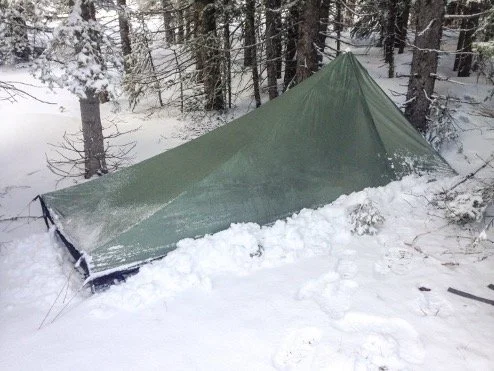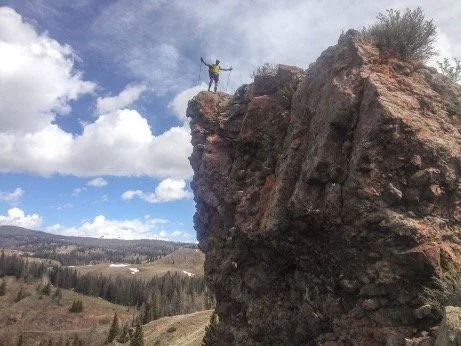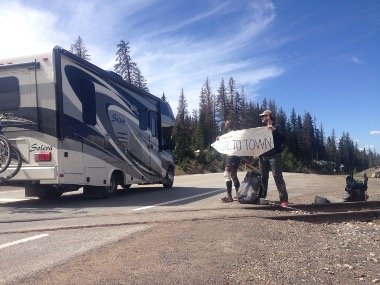Decision Time in the Southern Rockies: Cuba to Chama
I was asleep in my tent above 10,000 feet, in the San Pedro Mountains north of Cuba, New Mexico, when I awoke to a strange pressure on my legs.
In a fog of drowsiness, I sat up. Felt my nylon tent roof.
What the hell is going on? I thought. What is this?
…Bowing… Cold…Wet…
Snow!
I punched and kicked the roof of my tent till the frozen shards smashed up and slid off. The tent then righted itself, and I sat there — wide awake, cold and bewildered.
I didn’t sleep well that night. The snow kept falling. I feared it would build on the roof of my tent, piling like it does on the eaves of a home, and cause a catastrophic failure. I got up twice to shake it off my roof.
At one point in my half-wakefulness I heard a loud wrenching sound. It came from where my friends were encamped. I was curious, but I could see my breath: Too cold to poke out my head and look. Instead I pulled my silk sleeping bag liner up around my face and tugged the drawstring of my mummy bag so that it drew tightly around my head. Snug as a bug — with only my nose and mouth exposed to breathe in the icy air — I drifted in and out of a restless sleep, wondering all the while what had caused that eerie tearing.
In the morning, I found out.
Snow dropping off tree branches piled on Memphis’s tent, snapping a pole and ripping it through the nylon. The wrenching was his rigging the tent so it would shelter him through the night.
Memphis’s tent failure was only the beginning of our troubles. As it turns out, snow will likely be the deciding factor on the trail this year.
According to recent Snotel snowpack figures, Colorado is at 157 percent of average snowpack. I am now in Chama, New Mexico, knocking on the door of the San Juan Mountains of Southern Colorado. Those peaks are at about 160 percent of average snowpack. The Divide being the Divide, we’re set to go right over them. That means a tough slog, and many hikers are looking for options to get around it. It’s somewhat discouraging — especially given this was supposed to be the perfect year to hike the CDT. Back in April snow levels were 50 percent below average. That the mountains are so socked in is a testament to how wet a month it’s been in the region. Ultimately, I suppose it’s a good thing: The greater good is replenishing this drought-stricken land. But for CDT hikers, the loads of late-season snowfall means the Colorado high country will require miles and miles of traversing snowbound terrain.
The choices — so far as I can tell — are to quit; get a ride up to the deserts of Wyoming and hike south; take a lower alternate called the Creede Cutoff; or plow on through the snowy San Juan peaks. I mull the latter three options daily and have yet to fully decide on which is best.
And yet — even with the snowy sections — the walk to Chama was a strenuous delight, punctuated with an ensemble of strange rocks, vivid green meadows, thick stands of quaking aspen, jaunts across sections of Alpine tundra — biomes at and above tree line, carpeted in green, spongy lichens — sightings of large elk herds and gray jays and magpies and a few coyotes and a galumphing black bear and some hikers (not me ….) have even seen wolves.
Our first tastes of the high country. The Southern Rocky Mountains.
Arriving at Ghost Ranch
After climbing the San Pedros we descended into the Chama River Valley, where the turbid waters rushed through canyons of layered rock formations — brick red and lipstick pink and banana yellow and graphite gray. We spent a night at Ghost Ranch, near Abiquiu, where we got a shoebox of a room for $25 each. Ghost Ranch is surrounded by the same colorful sedimentary cliffs as the Chama River Valley. I went to the library to be quiet for a little and read about the cliffs. I found out they formed during the Triassic and Jurassic periods — the latter being the Age of the Reptiles, which occurred as the Pangea supercontinent was torn asunder. The multi-colored rock layers result from sedimentary deposits being laid down at different ages in the past.
Fast forward some 150-200 million years, and these selfsame rocks inspired the famous landscape paintings of Georgia O’Keefe. I don’t know much about Georgia O’Keefe but I did see a quote by her that I like because of its truth and the simple language of it and its zen-like sensibility: “Nobody sees a flower; it is so small. We haven’t time. And to see takes time — like to have a friend takes time.”
Walking with friends
Chimi, Memphis and I left Ghost Ranch with two new hiking friends: Kramers and Sanjay. We wound through a box canyon and soon entrained with two more hikers: Dutch and Main Man. A big crew to tackle the roughly 90 miles to Chama. And a fun crew, too.
Kramers is originally from Hawaii. He’s hiked about 800 miles of the Pacific Crest Trail and completed the entire Appalachian Trail. I didn’t bring enough food on this last leg and whenever I came around, nonchalantly grousing, saying things like, “Hey Kramers, what’s that you got there?” or “Boy, whatever it is you’ve got cooking sure does smell good” — he always hooked it up. In all seriousness, though: I would have been a pretty hungry camper coming in to Chama without his help. Gracias, amigo.
Sanjay works part of each year in a California bike shop to fund his wanderlust addiction. He used to race mountain bikes and got the nickname “The World’s Fastest Indian.” He’s ridden his bike over some of the highest passes in the world; hiked the PCT as well as the Annapurna Circuit — a nearly 150-mile trek in the Himalayas; and driven a motorcycle in the Baja 1,000, the famous off-road race in Mexico, among various other adventures. He’s currently at the outset of what’s likely to be a multi-year scooter-and-biking journey. For this he outfitted his scooter with an unusual bike rack. The front of his bike attaches to the rear of his scooter, with the back bike wheel rolling on the ground. He’s already driven this rig across much of the country, puttering along in emergency lanes at about 40 miles per. “It looks like a circus act,” he told me. “People keep stopping and taking pictures.”
After the CDT he plans to pick up his bike which he dropped off in Montana and ride it to a place near Albuquerque where he previously stowed his scooter with friends. From there, it’s eventually down south, through Latin America, and off to see the world
Maine Man – aka Maine Guy – is the oldest in our crew, though nobody really knows his exact age. Somebody once asked if he was in his 40s, and he said, with a smile, “Sure. That sounds good. It’s something like that.” He farms his roughly 70-acre property in Maine, living almost entirely off the land. He sports a full-on mountain man beard and walks with a wooden staff he found during a hike in Idaho. Since Maine Man picked up the staff some years ago, it has in the neighborhood of 3,000 hiking miles on it.
Dutch is a big dude from North Carolina, weighing in at about 220 pounds. He’s also thru-hiked the PCT and AT. He used to play fly-half on his college rugby team. When we hit big snowdrifts, he takes his size 14 shoes and goes off sledgehammering through the crust so the rest of us can walk in his footsteps. At one point early in the morning, we arrived at a fast-rushing river: Rio Vallecitos. The log-bridge had apparently washed out, so we had no choice but to ford it. As we all stood there preparing, Dutch turned to the bank.
Well,” he said. “I guess I’ll be the guinea pig.”
And off he went, battling the current.
Postholing Apocalypse
The last 10-15 miles to Cumbres Pass — virtually all the area along the main route from Lagunitas Campground to the pass — were the most brutal we’ve had — all owing to snow. We waded for miles through forested slopes blanketed in thick snowdrifts, ranging in depth from 4 to 15 feet. Since the trail is buried, we relied on Sanjay and his GPS navigational skills or found tracks from other hikers. The snow typically had a thin crusty layer of ice. When your feet punch through, the crust rakes up your shin. Several guys on the team started bleeding. I had a pair of red, white and blue socks with holes in the toes. I widened the toe-holes and pulled them up my legs as shin guards.
Lunging through the snow, sinking to your knee or thigh or crotch, lunging again – miles of this, in sopping wet shoes and socks. Everyone calls this method of travel postholing. It’s utterly exhausting. Sometimes you might walk 10 feet on a layer of frozen crust only to hit something like a trap door. You drop in, either hit the bottom or strike oil, and then take a step to climb out – but that shoe sinks in as well. So then you have to lay out on the snow like some sort of beached marine animal and wallow back onto your feet.
At the end of our worst night of postholing, I came around the corner with Sanjay, and Chimi and Dutch had gathered wood for a fire. The four of us gathered around the heat and made a fire ring of wet shoes and wet socks. As the flames pulled moisture from our shoes, steam rose into the air.
The next day, we passed into Colorado – an exciting landmark for all of us. For me, New Mexico marks the first state I’ve ever walked through in my entire life. Roughly 650 miles. Hawt Dog!
We traversed a ridge and floundered down snowslopes to Cumbres Pass. From there, we hitched into town, snagging rides from friendly folks in two trucks.
To Press or Flip?
Because of the snow, groups of hikers have rented vehicles to drive to The Great Basin of Wyoming. They plan to hike south from Lander and hope the snow will melt out by the time they get back to the big mountains in Colorado. Others are slowing their pace, taking time off in Taos or Santa Fe or other places. I also know of at least one person who’s gone home – the idea being to wait for a while and see if the snow will melt. At the same time, we all feel pressure to keep moving, because if you delay you run the risk of not making it to Canada before heavy snowfall in September and October in Montana.
I got an ice axe and crampons and warm gloves in my Chama resupply box. The plan at the moment is to stick with the group and push through the South San Juans. Also, my family and friends pitched in and bought me a new camera after they read what happened at El Malpais. I’m charging it now. Thanks so much!













